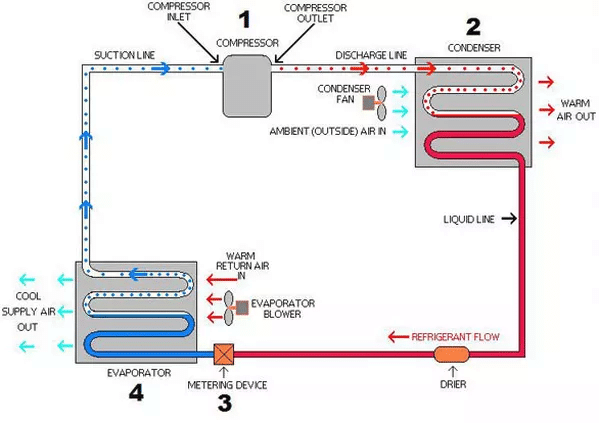In our inspection reports, we often state that the air conditioning cooling system failed the balance or the TD test.
So what is the world is an AC Balance Test?
The AC Balance Test is slang for the AC Temperature Differential Test. It is the difference between the temperature of the air going into an air conditioner and the temperature of the air coming out. It is also called the “delta T” by HVAC professionals.
Let’s review what is happening using the following diagram:
The condensing unit, located outside of the house, sends coolant back inside the house to the Evaporator Unit where the coolant is cooled to a low temperature of about 25 degrees before it enters the evaporator coils. A fan blows room temperature air from the return air vent across the condensing coils. The air is chilled to about 55º F and vented back to the house through the ductwork and exits at the registers.
To conduct the Temperature Differential test, the temperature is measured at the return air vent (warm air) and at the air conditioning registers (cool air). The difference should be between 14º F to 20º F with 18º F to 20º F being ideal.
It is possible for the air to be too warm or too cold exiting the registers. Either extreme indicates the AC unit is not functioning properly.
Almost all of our home inspections that failed the AC TD test do it on the low end. The air is not being chilled sufficiently. Probable causes are dirty air filters, which restrict the amount of air being blown across the condensing coils, or low coolant, which does not allow the condensing coils to reach the desired temperature to cool the air. There could be other conditions which could contribute to this such as does the house sit in direct sunlight? What is the outdoor temperature? Are the condensing coils constricted with grass and leaves? Are there leaks in the duct work? Is the unit sized and metered properly for the size of the house?
A temperature difference greater than 20º is an indication that the evaporator coils may be icing up. This restricts the volume of air being returned to the room. The air is cold, but there is not much of it.
At Magnolia Home Inspection Services, we use either a temperature laser gun or a thermal imaging camera to measure the temperatures at the return air and at the registers. From our research, using temperature probes does not change the test results.
10 Low Cost Ways to Improve Air Conditioner Efficiency
- Clean around outdoor condenser unit to remove grass and leaves.
- Vacuum indoor vents. Remove obstructions to vents.
- Increase your thermostat by a few degrees.
- Keep lamps and other heat producing appliances away from thermostats.
- Keep curtains and blinds closed.
- Clear your drain line exiting the evaporator coils.
- Avoid using your oven, stove, and clothes dryer during the hotest times of the day. v
- Seal any ductwork that is leaking air with duct.
- Caulk doors and windows.
- Replace weather stripping around external doors.
Sources:
Central Heating & Air Conditioning
https://www.centralhtg.com/blog/8-no-cost-ways-to-improve-air-conditioning-efficiency



